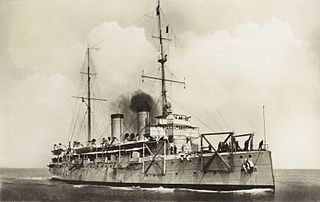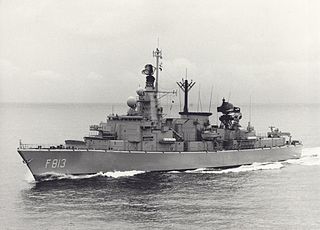
HNLMS De Ruyter was a light cruiser of the Royal Netherlands Navy. She was originally designed as a 5,000 long tons (5,100 t) ship with a lighter armament due to financial problems and the pacifist movement. Later in the design stage, an extra gun turret was added and the armor was improved. She was the seventh ship of the Dutch Navy to be named after Admiral Michiel Adriaenszoon de Ruyter.

HNLMS Jacob van Heemskerck was the second and last of the Tromp-class light cruisers of the Royal Netherlands Navy, named after Admiral Jacob van Heemskerk (1567–1607).

HNLMS Tromp was the lead ship of the Tromp-class destroyer leaders built for the Royal Netherlands Navy. Built just prior to World War II, the ship served mainly in the Pacific and Indian Oceans against the Japanese, being based out of Sydney, Fremantle and Trincomalee where she served alongside British, Australian and US warships. After the war, she returned to the Netherlands; after 1949,Tromp was used as a training and accommodation ship, before being decommissioned in 1955, and scrapped in 1969.

The De Zeven Provinciën class was a class of light cruisers. They were built by Rotterdamsche Droogdok Maatschappij (RDM) and Wilton-Fijenoord for the Royal Netherlands Navy. The name De Zeven Provinciën refers to the seven provinces which formed the Dutch Republic in 1581.

BAPAlmirante Grau(CLM-81) is a De Zeven Provinciën-class cruiser that served in the Dutch and Peruvian navies. Completed for the Dutch in 1953 as HNLMS De Ruyter (C801), she was acquired by Peru in 1973 and served as fleet flagship. Almirante Grau underwent a major modernization program between 1985 and 1988 during which she was fitted with new weapons and electronics. She was the last gun cruiser in service in any navy before being decommissioned on 26 September 2017. In 2019, it was to be said that she would be preserved as a museum ship. However, it was later announced on 14 February 2022 that the ship would put up for sale with an asking price of 4,180,000 soles.

Coastal defence ships were warships built for the purpose of coastal defence, mostly during the period from 1860 to 1920. They were small, often cruiser-sized warships that sacrificed speed and range for armour and armament. They were usually attractive to nations that either could not afford full-sized battleships or could be satisfied by specially designed shallow-draft vessels capable of littoral operations close to their own shores. The Nordic countries and Thailand found them particularly appropriate for their island-dotted coastal waters. Some vessels had limited blue-water capabilities; others operated in rivers.

HNLMS Gelderland was a Holland-class protected cruiser of the Royal Netherlands Navy. During its career in the Dutch Navy it was most notable for being the ship Queen Wilhelmina sent to Portuguese East Africa to transport Paul Kruger to Europe during the Second Boer War. The ship was taken over by the Germans during World War II, rebuilt as an anti-aircraft cruiser and renamed Niobe. Commissioned into the German navy on 1 March 1944, she was sunk in Kotka harbour in Finland on 16 July 1944.

HNLMS De Zeven Provinciën was a De Zeven Provinciën-class cruiser of the Royal Netherlands Navy. Laid down in 1939, construction was interrupted by World War II and the ship was only commissioned in 1953 with the identification number C802. She served until 1976 when she was purchased by Peru and renamed Aguirre. With the Peruvian Navy she served until 1999 and was scrapped in 2000.

The Holland-class destroyers were built for the Royal Netherlands Navy in the 1950s. They were the first major warships designed and built by the Dutch after World War II. In contrast to previous Dutch Navy practice the ships were named after provinces rather than admirals.

HNLMS Zuiderkruis (A832) was a replenishment oiler operated by the Royal Netherlands Navy. Zuiderkruis entered service in 1975 and was decommissioned on 10 February 2012. Her design was based on the earlier replenishment ship Poolster. The ship has been stripped for parts and left Den Helder for scrapping in Turkey on 21 February 2014.

The 15 cm SK L/40 was a German naval gun that was used as secondary armament on pre-dreadnought battleships, protected cruisers and armored cruisers of the Imperial German Navy in World War I. It was also used as a coast-defence gun during World Wars I and II.

The Holland class was a class of six protected cruisers of the Royal Netherlands Navy. The class was built in two groups, each consisting of three ships.

HNLMS Friesland was a Holland-class protected cruiser of the Royal Netherlands Navy.

The destroyer HNLMS Tjerk Hiddes was a British built, Dutch warship of World War II. She was laid down on 22 May 1940 as a British N-class destroyer and launched on 25 June 1941 as HMS Nonpareil, but on 27 May 1942, she was transferred to the Royal Dutch Navy. The ship was commissioned in 1942 as HNLMS Tjerk Hiddes, named after the 17th century Dutch admiral, Tjerk Hiddes de Vries. Much of her war service was with the Royal Navy and United States Navy in the Indian Ocean and Australia. Following the war, the destroyer was sold to Indonesia and renamed RI Gadjah Mada. She was scrapped in 1961.

HNLMS Zeeland (D809) was a destroyer of the Holland class. The ship was in service with the Royal Netherlands Navy from 1955 to 1979. The destroyer was named after the Dutch province of Zeeland and was the twenty-first ship with this name. In 1978 the ship was taken out of service and later broken up and scrapped. The ship's radio call sign was "PAAU".

HNLMS Tromp (F801) was a frigate of the Tromp class. The ship was in service with the Royal Netherlands Navy from 1975 to 1999. The frigate was named after Dutch naval hero Tromp. The ship's radio call sign was "PADE".

HNLMS Witte de With (F813) was a frigate of the Jacob van Heemskerck class. The ship was in service with the Royal Netherlands Navy from 1986 to 2006. The frigate was named after Dutch naval hero Witte Corneliszoon de With. The ship's radio call sign was "PAVP".

HNLMS Jacob van Heemskerck (F812) was a frigate of the Jacob van Heemskerck class. The ship was in service with the Royal Netherlands Navy from 1986 to 2004. The frigate was named after Dutch naval hero Jacob van Heemskerck. The ship's radio call sign was "PAVO".

HNLMS Bloys van Treslong (F824) was a frigate of the Kortenaer class. The ship was in service with the Royal Netherlands Navy from 1982 to 2003. The frigate was named after Dutch naval hero Willem Bloys van Treslong. The ship's radio call sign was "PADG".



















